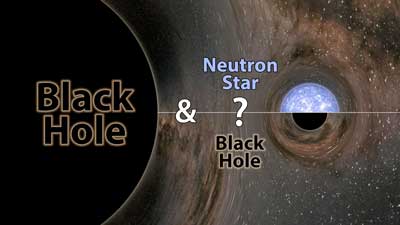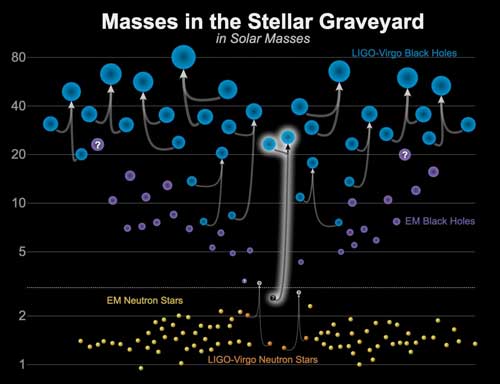| Jun 24, 2020 |
LIGO-Virgo finds mystery astronomical object in 'mass gap'
|
|
(Nanowerk News) An international research collaboration, including Northwestern University astronomers, has detected a mystery object inside the puzzling area known as the "mass gap" -- the range that lies between the heaviest known neutron star and the lightest known black hole. The finding has important implications for astrophysics and the understanding of low-mass compact objects.
|
|
When the most massive stars die, they collapse under their own gravity and leave behind black holes; when stars that are a bit less massive than this die, they explode in a supernova and leave behind dense, dead remnants of stars called neutron stars. The heaviest known neutron star is no more than 2.5 times the mass of our sun, or 2.5 solar masses, and the lightest known black hole is about 5 solar masses. For decades, astronomers have wondered: Are there any objects in this mass gap?
|
|
Now, in a new study from the National Science Foundation's Laser Interferometer Gravitational-Wave Observatory (LIGO) and the European Virgo observatory, scientists have announced the discovery of an object of 2.6 solar masses, placing it firmly in the mass gap.
|
 |
| In August of 2019, the LIGO-Virgo gravitational-wave network witnessed the merger of a black hole with 23 times the mass of our sun and a mystery object 2.6 times the mass of the sun. Scientists do not know if the mystery object was a neutron star or black hole, but either way it set a record as being either the heaviest known neutron star or the lightest known black hole. (Image: LIGO/Caltech/MIT/R. Hurt (IPAC))
|
|
The intriguing object was found on Aug. 14, 2019, as it merged with a black hole of 23 solar masses, generating a splash of gravitational waves detected back on Earth by LIGO and Virgo. A paper about the detection was published by The Astrophysical Journal Letters ("GW190814: Gravitational Waves from the Coalescence of a 23 Solar Mass Black Hole with a 2.6 Solar Mass Compact Object").
|
|
"Mergers of a mixed nature -- black holes and neutron stars -- have been predicted for decades, but this compact object in the mass gap is a complete surprise," said Northwestern's Vicky Kalogera, who coordinated writing of the paper. "We are really pushing our knowledge of low-mass compact objects. Even though we can't classify the object with conviction, we have seen either the heaviest known neutron star or the lightest known black hole. Either way, it breaks a record."
|
|
Kalogera, a leading astrophysicist in the LIGO Scientific Collaboration (LSC), is an expert in the astrophysics of compact object binaries and analysis of gravitational-wave data. She is the Daniel I. Linzer Distinguished University Professor of Physics and Astronomy and director of CIERA (Center for Interdisciplinary Exploration and Research in Astrophysics) in Northwestern's Weinberg College of Arts and Sciences.
|
|
"Whereas we are not sure about the nature of the low-mass compact object, we have obtained a very robust measure of its mass, which falls right into the so-called mass gap," said Mario Spera, a co-author of the paper who studies the formation of merging binaries. He is a Virgo collaboration member and a European Union Marie Curie Postdoctoral Fellow at CIERA and the University of Padova.
|
|
"This exciting and unprecedented finding, combined with the unique mass ratio of the merger event, challenges all the astrophysical models that try to shed light on the origins of this event," Spera said. "However, we are quite sure that the universe is telling us, for the umpteenth time, that our ideas on how compact objects form, evolve and merge are still very fuzzy."
|
|
The cosmic merger described in the study, an event dubbed GW190814, resulted in a final black hole about 25 times the mass of the sun. (Some of the merged mass was converted to a blast of energy in the form of gravitational waves). The newly formed black hole lies about 800 million light-years away from Earth.
|
 |
| This graphic shows the masses for black holes detected through electromagnetic observations (purple), the black holes measured by gravitational-wave observations (blue), the neutron stars measured with electromagnetic observations (yellow), and the neutron stars detected through gravitational waves (orange). GW190814 is highlighted in the middle of the graphic as the merger of a black hole and a mystery object around 2.6 times the mass of the sun. (Image: LIGO-Virgo/ Frank Elavsky & Aaron Geller / Northwestern)
|
|
Before the two objects merged, their masses differed by a factor of nine, making this the most extreme mass ratio known for a gravitational-wave event. Another recently reported LIGO-Virgo event, called GW190412, occurred between two black holes with a mass ratio of about 4:1.
|
|
In addition to Kalogera and Spera, the other Northwestern researchers involved in the study are Chase Kimball, Christopher Berry and Mike Zevin. The three are authors of the paper and members of CIERA.
|
|
Kimball, an astronomy Ph.D. student and LSC member, assessed how often mergers such as GW190814 occur in the universe. Berry, the CIERA Board of Visitors Research Professor, is a member of the LSC Editorial Board for all LSC publications and served as the lead representative for this study. Zevin, an astronomy Ph.D. student and LSC member, contributed to the astrophysical interpretation and also to writing the GW190412 discovery paper.
|
|
"It's a challenge for current theoretical models to form merging pairs of compact objects with such an extreme mass ratio in which the low-mass partner resides in the mass gap," Kalogera said. "This discovery implies these events occur much more often than we predicted, making this a really intriguing low-mass object.
|
|
"The mystery object may be a neutron star merging with a black hole -- an exciting possibility expected theoretically but not yet confirmed observationally," she said. "However, at 2.6 times the mass of our sun, it exceeds modern predictions for the maximum mass of neutron stars and may instead be the lightest black hole ever detected."
|
|
"Whether or not the object is a heavy neutron star or a light black hole, the discovery is the first in a new class of binary mergers," Kimball added. "Models of binary populations will have to account for how often we now can infer that these sort of events occur."
|
|
When the LIGO and Virgo scientists spotted this merger, they immediately sent out an alert to the astronomical community. Dozens of ground- and space-based telescopes followed up in search of light waves generated in the event, but none picked up any signals.
|
|
|
|
So far, such light counterparts to gravitational-wave signals have been seen only once, in an event called GW170817. The event, discovered by the LIGO-Virgo network in August of 2017, involved a fiery collision between two neutron stars that was subsequently witnessed by dozens of telescopes on Earth and in space. Neutron star collisions are messy affairs with matter flung outward in all directions and are thus expected to shine with light. Conversely, black hole mergers, in most circumstances, are thought not to produce light.
|
|
According to the LIGO and Virgo scientists, the August 2019 event was not seen in light for a few possible reasons. First, this event was six times farther away than the merger observed in 2017, making it harder to pick up any light signals. Secondly, if the collision involved two black holes, it likely would have not shone with any light. Thirdly, if the object was in fact a neutron star, its nine-fold more massive black-hole partner might have swallowed it whole; a neutron star consumed whole by a black hole would not give off any light.
|
|
"I think of Pac-Man eating a little dot," says Kalogera. "When the masses are highly asymmetric, the smaller compact object can be eaten by the black hole in one bite."
|
|
How will researchers ever know if the mystery object was a neutron star or black hole? Future observations with LIGO and possibly other telescopes may catch similar events that would help reveal whether additional objects exist in the mass gap.
|
|
"The mass gap has been an interesting puzzle for decades, and now we've detected an object that fits just inside it," said Pedro Marronetti, program director for gravitational physics at the National Science Foundation (NSF). "That cannot be explained without defying our understanding of extremely dense matter or what we know about the evolution of stars. This observation is yet another example of the transformative potential of the field of gravitational-wave astronomy, which brings novel insights to light with every new detection."
|


